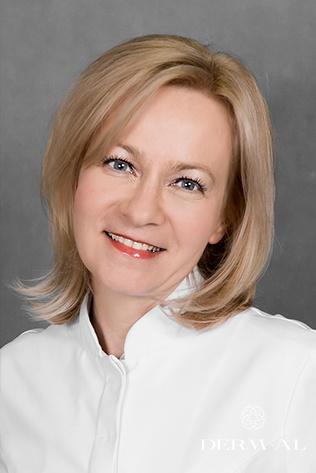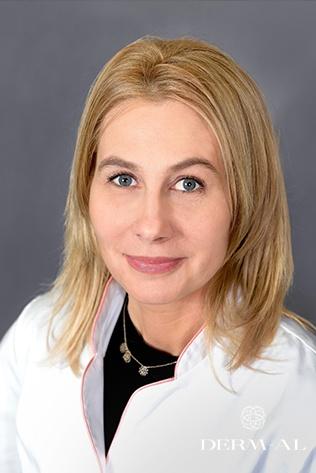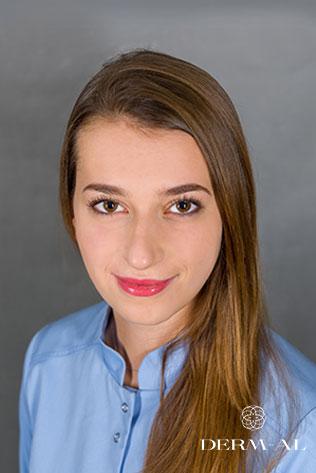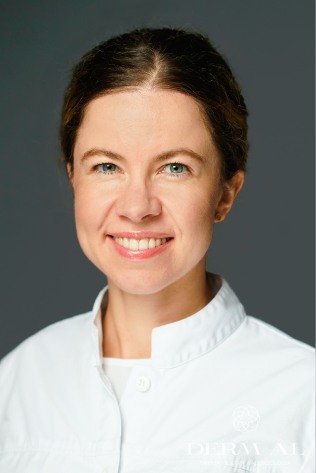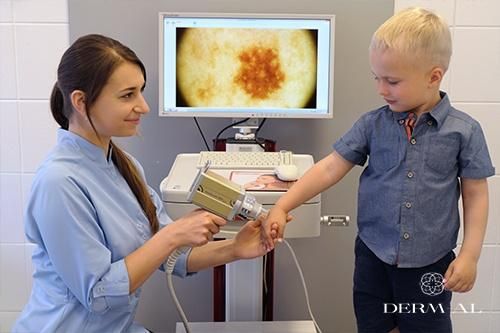Modelling the facial oval, volumetric treatment
- Description of the treatment
-
At Derm-Al Beauty, physicians use the latest face modelling technologies. In volumetric treatment, they use both hyaluronic acid products and other substances, such as calcium hydroxyapatite, l-polylactic acid, polycaprolactone or auto fat transfer. Also, lifting threads are used to lift face contours.
With age, the facial features droop, making the face look sad and old. However, there are many ways to improve the appearance. Depending on the case, it is possible to lift drooping areas, such as lip corners, nasolabial folds, chin, lower parts of the jaws (so-called “hamsters”) as well as refill the tissue: hollow cheeks, temple and jaw join area and restore the shape and firmness of the cheeks.
Volumetric treatment with hyaluronic acid:
The type of hyaluronic acid suitable for refilling large and deep hollows and increasing the volume of the face is cross-linked hyaluronic acid of the highest density (more information on hyaluronic acid here: link do fragmentu o kwasie z działu Wypełnianie zmarszczek). The procedure is performed with a needle or cannula. A cannula, unlike a needle, is flexible and blunt, which enables maneuvering it under the skin to avoid blood vessels. The cannula requires only two injections (one on each side of the face), which reduces pain and unnecessary marks caused by the treatment. The effect is immediate and lasts for 9 to 24 months. Hyaluronic acid absorbs in the area of injection, but it also stimulates the reconstruction of collagen. With each subsequent application, the effect lasts longer.
Treatment with calcium hydroxyapatite (Radiesse, Neauvia):
Calcium hydroxyapatite, the same as hyaluronic acid, is a natural component of the human body: it is the building material of bones and teeth. In filler products, it has the form of hydroxyapatite micro-balls suspended in a gel with high water content. The gel ensures an instant lifting effect and the mineral contained in its formula builds a scaffolding in the skin and stimulates the synthesis of new collagen fibres. The preparation stimulates reconstruction of areas with fat tissue and bone tissue atrophy, and it improves the skin's condition, making it firmer and thicker. Application of calcium hydroxyapatite gives natural rejuvenating effects. The substance may be used as an alternative to hyaluronic acid preparations, with the exception of the mouth. The best effects are achieved in the area of the cheekbones, nasolabial folds and temples, and in evening the bridge of the nose. The treatment involves injecting the preparation - usually with a cannula - into specific spots. The effect of calcium hydroxyapatite in the skin lasts for around 2 years.
Treatment with L-polyactic acid (Sculptra)
L-polyactic acid is another chemical substance that naturally occurs in the human body. Of all the available preparations, it is the strongest stimulant of collagen synthesis. The filling effect is gradually achieved over a couple of weeks. It is not the direct effect of injecting the preparation, but rather of own collagen synthesis. Because the effect develops over time, the natural appearance is maintained. The skin in the areas of injection becomes denser and it recovers its natural youthfulness. Recommendations for the procedure are: nasolabial folds, sunken cheeks, drooping chin, visible folds in the corners of the mouth (puppet’s lines), sagging skin face. The preparation must be prepared between 72 and 24 hours before the treatment. If it is not used within this time, it gets wasted. It is applied with a very thin needle to a given area of the skin and then massaged by the physician to make sure that it spreads evenly. Home massage is also recommended. It is good to treat L-polyactic acid procedure as therapy and repeat it 2-3 times, after two weeks at the earliest.
Procedures with polycaprolactone (Ellanse)
Polycaprolactone is another collagen stimulating substance, non-toxic and biodegradable, suspended in a gel. The gel provides an instant filling effect and the chemical properties of the preparation ensure a long-lasting effect and stimulate collagen reconstruction. Aesthetic medicine preparations based on polycaprolactone differ in the length of the individual active substance chain, based on which it is possible to determine the duration of the effect (Ellanse S - lasts for 12 months, Ellanse M - 18 months, Ellanse L - 24 months, Ellanse E - more than 36 months). After application, the face recovers its volume, the skin quality improves and the effect lasts for long. The treatment is performed with a needle or cannula.
Lipolifting - filling treatment with auto fat transfer (Puregraft system)
The treatment involves micro-transfer of adipose tissue from the abdomen, thighs, hips or knees to the areas that require increasing the volume. At the Derm-Al Centre, lipolifting is performed by a plastic surgeon in local anaesthesia, using the sterile Puregraft system manufactured by Establishment Labs S.A. Puregraft is a specialist, closed system that guarantees the sterility of the procedure and highly purified adipose tissue. The special type of filtration generates fat that is free of blood and lipids, without damaging fat cells. This way, the treatment is safer, and the effects are possible to predict. Auto fat is a natural filler, it eliminates the risk of an allergic reaction of the body, and the stem cells it contains have strong regenerative and revitalising properties and stimulate collagen synthesis, tension, elasticity and tone of the skin. Auto fat transfer is recommended where a large amount of filler is needed to achieve the desired effect. Fat is more elastic and softer than hyaluronic acid used in volumetric procedures, thus even if large amounts of it are transferred, the effect is natural and long-lasting. The treatment may be combined with surgical lifting of the skin.
PDO lifting threads (First Lift, First Lift Barb)
PDO (polydioxanone) is a synthetic fibre that has been used in medicine for many years. Formerly, it was used only for cutaneous and subcutaneous stitches in surgery. It was adopted in aesthetic medicine when it was discovered through clinical observations that polydioxanone stimulates the synthesis of collagen in tissue, fibroblasts and natural (endogenic) hyaluronic acid, improving the tension, firmness and vitality of the skin and giving good effects in rejuvenating procedures.
Thin PDO threads (first lift) are used in procedures that improve the condition of the skin, especially in the eye and eyebrow areas, the thin skin on the cheeks, above the mouth, on “smoker’s wrinkles” and on the neck and décolleté. Quite a few threads are implanted to form as if a mesh, which is supposed to support the tissue and stimulate the regeneration process. The effects of the treatment are the best visible after a month or two.
Slightly thicker PDO threads (First Lift Barb) that have special micro hooks not only revitalise but also pull up the tissue, providing a good lifting effect. The effect is visible after implanting a single thread. Threads are implanted with a cannula, in local anaesthesia, along the natural skin tension lines, which gives an effect similar to surgical lifting. PDO threads are absorbed at the latest within 9 months. However, they leave a kind of a scar under the skin, which, due to a higher density than the surrounding tissue, keeps the skin in its new, better position. After the treatment, the face may be swollen for a few days, and there may be some minor unevenness on the skin, but this should disappear within about 2 weeks. The effects of the treatment are natural and they usually last for 3 to 5 years.
-



